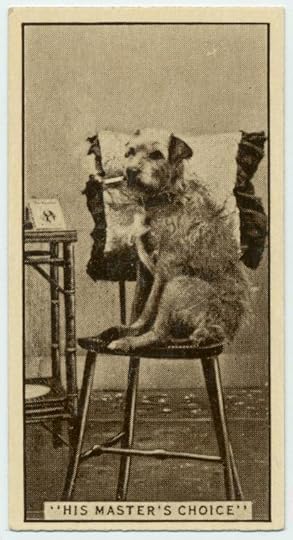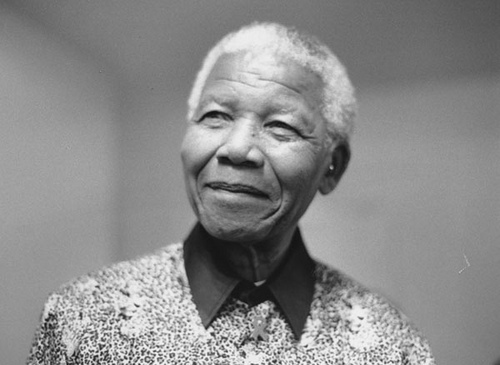Oxford University Press's Blog, page 1010
October 27, 2012
Pasqua Rosee and the coffee shop
Coffee shops are in the news, but where did it all begin?
Perhaps with this man, Pasqua Rosee (fl 1651-6), who opened London’s first coffee-house at St Michael Cornhill. Rosee’s coffee-house was a shed in St Michael’s churchyard. Here he served “two or three dishes” of coffee “at a time twice or thrice a day.” Rosee was also a champion of the new drink, publishing a handbill advertisement entitled “The Vertue of the Coffee Drink” (c.1652). Rosee claimed “coffee good against sore eyes… & will very much stop any defluxion of rheums… & so prevent the cough of the lungs.” His belief that coffee “will prevent drowsiness & make one fit for business” has proved more resilient than other claims for its benefits.
Rosee’s story, and that of London’s first coffee house, is also available for a listen in the ODNB biography podcast.
[See post to listen to audio]
The Oxford DNB online is freely available via public libraries across the UK and by subscription elsewhere. UK libraries offer ‘remote access’ allowing members to log-on to the complete dictionary, for free, from home (or any other computer) twenty-four hours a day. In addition to 58,000 life stories, the ODNB offers a free, twice monthly biography podcast with over 130 life stories now available. You can download it directly, or subscribe in iTunes or another service. You can also sign up for Life of the Day, a topical biography delivered to your inbox, or follow @ODNB on Twitter for people in the news.
Subscribe to the OUPblog via email or RSS.
Subscribe to only articles about British history on the OUPblog via email or RSS.



An Oxford Companion to James Bond
How well do you know your A-Z of James Bond?
‘Ah’, he says stroking a white fluffy cat, ‘we’ve been expecting you’. Leave Ms Moneypenny with a peck on the cheek, stash your Walther PPK in your back pocket and jump into our Aston Martin so you can join us as we speed through an A to Z of Bond fun, fact, and fiction. We have stories about Roger Moore’s penchant for love-making, tales of fictional islands, and even anecdotes about crocodile jumping. We’ve devoured OUP’s online reference works to bring you a delicious helping of double 0 heaven. Welcome to the world of Bond, James Bond.
A: Aston Martin

The Aston Martin [see Oxford Reference] is a car which has become synonymous with the film figure of James Bond. Appearing in six films, the sleek, smooth, and very sexy Aston Martin DB5 projects many of the same characteristics as its driver. In 2012, the original 1964 Aston Martin DB5, which featured in Goldfinger and Thunderball, sold for £2.6 million to a collector. Some of the special features of the car included revolving licence plates, an ejection seat, and a bullet-proof shield. It may surprise you to know that in the James Bond novels Ian Fleming chose the Bentley as Bond’s favourite vehicle, but the seductive design of the Aston Martin won over film makers.
B: Bond, James Bond
With his quick quips, timeless good looks, and irresistible charm, the character of James Bond [Oxford Reference] has global appeal. The brain-child of Ian Fleming [ODNB], ‘007: License to Kill’ has become one of the most recognised fictional characters in world literature and world cinema. The infamous Bond quote ‘The name’s Bond, James Bond’ can be found in The Oxford Essential Quotations but there are so many “Bond-isms” that have helped colour the character of Her Majesty’s most dangerous spy. Many a young gentleman, me included, have walked into a cocktail bar and ordered a vodka martini, shaken not stirred.
However, in the life of Bond, two motifs remain invariable. Firstly, Bond will get the girl. With his enviable euphemism-laden one-liners and piquant wit, coupled with a dapper dress-code, Bond’s seduction knows no boundaries. Secondly, he will inevitably triumph over his foe, usually after an epic battle. Such battles have taken place in remote locations such as the ice-plains in Iceland, the fictional island of San Monique, and a space shuttle! James Bond even appears in Oxford Dictionaries Online!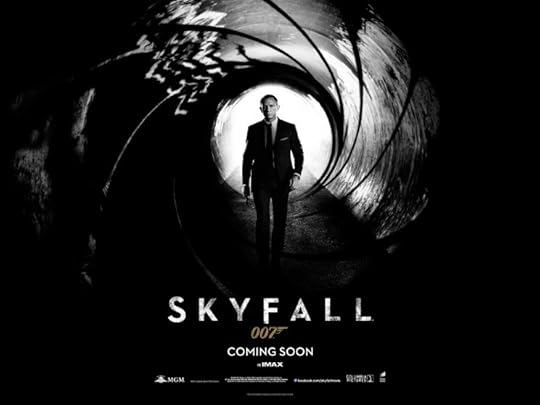
C: Crowley as Le Chiffre
Le Chiffre, the antagonist in Casino Royale, is one of the most deranged villains in the history of Bond. The only thing more terrifying than his delight in torture is the fact that he is based on a real life character: the early twentieth century occultist Aleister Crowley [ODNB]. Dubbed the ‘wickedest man in the world’ by British periodical John Bull, death stalked Crowley in his meanderings around the globe. First, he shot two assailants in India. Then, he dragged his wife and daughter to visit him in Asia: his daughter contracted a virus and died in Burma. Several years later, several of his ‘disciples’ died in mysterious sexual and occultist rituals in Sicily which led the Italian Government to expel him and the rest of his cult. Fleming’s Le Chiffre shares many of Crowley’s characteristics. Like Crowley, Le Chiffre’s wanderings around the globe mean that nothing is known about him except the number in his passport – hence the name ‘Le Chiffre’ which translates as ‘the number’ [Oxford Language Dictionaries Online]. He also has a reputation for practicing dark magic and using forms of sexual torture: remember the scene that led to the simultaneous crossing of millions of men’s legs worldwide as Le Chiffre repeatedly whipped Bond in the testicles with a knotted rope? Thought so.
D: Dr. No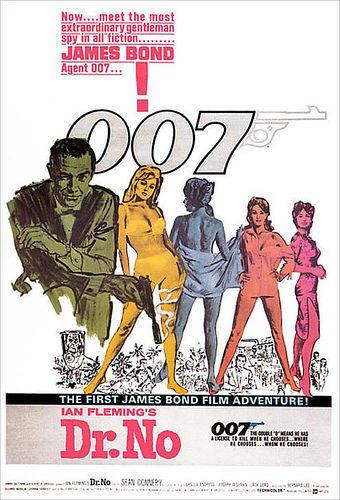 In 1962 the first James Bond film Dr No hit cinema screens, starring the fantastically debonair Sean Connery [Who's Who]. In his first film mission, Bond is sent to solve the mysterious death of his fellow agent. His assignment takes him to Jamaica [Oxford Reference], where he meets the beautiful Honey Ryder and faces battle with the evil Dr. No. The film was based on Ian Fleming’s sixth Bond book of the same name which published in 1958 and was directed by Terence Young [ODNB], a British screenwriter and film director who also went on to direct From Russia With Love and Thunderball.
In 1962 the first James Bond film Dr No hit cinema screens, starring the fantastically debonair Sean Connery [Who's Who]. In his first film mission, Bond is sent to solve the mysterious death of his fellow agent. His assignment takes him to Jamaica [Oxford Reference], where he meets the beautiful Honey Ryder and faces battle with the evil Dr. No. The film was based on Ian Fleming’s sixth Bond book of the same name which published in 1958 and was directed by Terence Young [ODNB], a British screenwriter and film director who also went on to direct From Russia With Love and Thunderball.
E: Erotic
From the moment that Ursula Andress walked out of the sea in her very small bikini in the film Dr. No to the latest sensual scene between Javier Bardem and Daniel Craig in Skyfall, viewers have come to expect sexual tension, amorous affairs, and charming one-liners from James Bond. Erotic scenes and sexual tension, ‘pertaining to the passion of love’ [OED definition of ‘erotic, adj. & n.], are expected in every Bond film and have resulted in Bond being known as one of the longest running onscreen Lotharios, having slept with 52 women over the course of 22 films. Famous sex scenes have included notorious stars such as Grace Jones [Oxford Index] as May Day in A View to A Kill and also some bizarre sexual turn-ons, such as the sadomasochistic tendencies of Xania Onatopp who brings herself to orgasm by crushing her lovers between her thighs.
F: Ian Fleming
It’s been 50 years since the Casino Royale book was published and the Bond franchise continues to go from strength to strength. However, it wasn’t always obvious that Fleming would be a successful writer. Floundering in the shadows of his ‘brilliant’ elder brother, Peter, Ian Fleming [ODNB] struggled to make an impact at Eton [Oxford Index] and, unlike his brother, was deemed unfit to study at Oxford. After contracting a venereal disease, his mother sent him off to a finishing school in Austria. He stayed in Europe for several years, studying at Universities in Munich and Geneva but he became more famous for his ‘extra-curricular activities’ than his intellectual prowess. He developed a reputation as a playboy that stayed with him until he married Ann Rothermere [ODNB] in 1952 (only after having an affair with her during her second marriage). It was this year that Casino Royale was published. His closest friends urged him to publish under a pseudonym. He had been a respected officer of the naval intelligence division during WWII and they worried that this type of novel would sully his reputation. Indeed, many journalists dismissed the ‘obscene’ and ‘sadistic’ content of the first Bond books. Yet, the sales figures disagreed and Fleming sold 30 million copies of Bond books during his lifetime and this figure doubled in the two years after his death. His legacy as the author of the James Bond books will last long in the annals of crime fiction; not bad for a University drop-out dismissed as a playboy.
To find out more about Ian Fleming, see his entry in the Oxford Dictionary of National Biography.
G: Goldfinger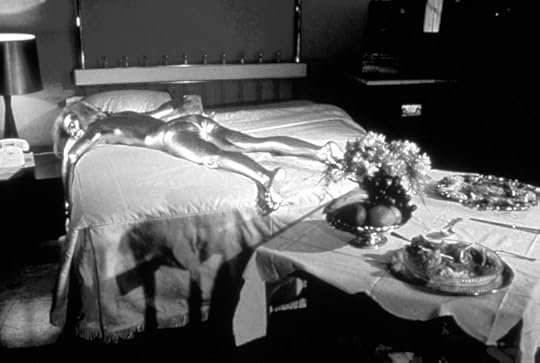 It is a widely circulated urban legend that the actress Shirley Eaton died from asphyxia during the production of Goldfinger in 1964 when she was painted head to toe in gold paint. It was believed in the 1960s that the pores in our skin aid our intake of oxygen and that being painted in metallic paint would result in death by suffocation. This was later disproved. However, although Shirley Eaton survived, the producers of the film were so cautious about the rumours of asphyxiation by paint that they made sure a small patch of her skin remained untouched during the filming process. One of the most memorable elements of the film Goldfinger is the soundtrack and, particularly, Shirley Bassey’s [Who's Who] theme song. Bassey was chosen to perform three of the Bond theme songs and her contribution to British show business was recognised by the award of a CBE in 1993 and a DBE in 2000. You can discover more about this theme song in this book by Jon Burlingame: The Music of James Bond.
It is a widely circulated urban legend that the actress Shirley Eaton died from asphyxia during the production of Goldfinger in 1964 when she was painted head to toe in gold paint. It was believed in the 1960s that the pores in our skin aid our intake of oxygen and that being painted in metallic paint would result in death by suffocation. This was later disproved. However, although Shirley Eaton survived, the producers of the film were so cautious about the rumours of asphyxiation by paint that they made sure a small patch of her skin remained untouched during the filming process. One of the most memorable elements of the film Goldfinger is the soundtrack and, particularly, Shirley Bassey’s [Who's Who] theme song. Bassey was chosen to perform three of the Bond theme songs and her contribution to British show business was recognised by the award of a CBE in 1993 and a DBE in 2000. You can discover more about this theme song in this book by Jon Burlingame: The Music of James Bond.
H: Heineken
James Bond and a vodka martini [Oxford Index]: one is a potent cocktail with dangerous ingredients and the other is an alcoholic beverage. For many a vodka martini, shaken not stirred (naturally), has become synonymous with James Bond. However, in an ambitious marketing campaign Heineken has secured one of the largest product placement packages in history. Heineken has a history of successful advertising campaigns, having coined the phrase ‘Heineken refreshes the parts other beers cannot reach’ [Oxford Dictionary of Quotations] in 1975, which has since gone onto become one of the most recognised advertising slogans in the food and drink industry.
Click here to view the embedded video.
I: Intelligence
MI6 [Oxford Reference], the secret intelligence service, is responsible for dealing with matters of internal security and counter-intelligence overseas. As James Bond’s employer, the Secret Intelligence Service provides the complex plot and missions for the character, while also supplying him with an array of new gadgets and weaponry.
If you are interested in MI6 and the Secret Intelligence Service you might enjoy The Oxford Handbook of National Security Intelligence ed. Loch K. Johnson.
J: Jaws
You would think that being smiled at is a good thing. Not so if the person doing the smiling is Jaws. Crammed with steel plated teeth, Jaws’ mouth is both a dentist’s nightmare and a formidable weapon. Seen biting through cable cars in The Spy Who Loved Me, actor Richard Kiel casts an intimidating presence at over seven feet tall, and has many brutal battles with Bond. The storyboard initially had Jaws die at the end of this film but because he was such a well-loved character (particularly by the director’s grandson) the producers and the director, Lewis Gilbert, changed the story to bring him back for Moonraker. In this film, he became more of a comedic figure and even helps Bond kill the evil Drax in the film’s finale. If you find yourself biting through metal or see people run away when you flash your pearly whites then maybe this is the book for you.
K: KGB
The national security agency for the Soviet Union from 1917-1991, the KGB [Oxford Reference] produced many operatives that either worked as Bond’s allies or worked against him during this period. First mentioned, fittingly, in From Russia With Love, the KGB are harbouring a Lektor Decoding Machine that Bond needs to steal for the MI6. The KGB became most active during the Cold War and real-life KGB sleeper spies are still active and being found in Britain and the USA today. If you would like to learn more about the history of the KGB and Russian intelligence then try Russian History: A Very Short Introduction by Geoffrey Hosking.
L: Live and Let Die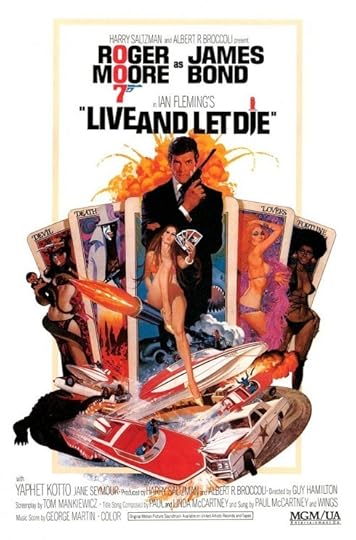 Live and Let Die is the eighth film in the James Bond film series, and the first to star Roger Moore [Who's Who] as Bond. This film marked several milestones for Bond films. It was the first time a fictional country would be used as a setting; in this case it was the fictional island of San Monique. It is also the only film which features a political assassination as Bond kills Kananga, leader of the fictional nation of San Monique, and the only Bond film not to feature the character of Q. The filming for Live and Let Die was done in a mixture of places to re-create the island of San Monique – Jamaica, Harlem, and Pinewood studios.
Live and Let Die is the eighth film in the James Bond film series, and the first to star Roger Moore [Who's Who] as Bond. This film marked several milestones for Bond films. It was the first time a fictional country would be used as a setting; in this case it was the fictional island of San Monique. It is also the only film which features a political assassination as Bond kills Kananga, leader of the fictional nation of San Monique, and the only Bond film not to feature the character of Q. The filming for Live and Let Die was done in a mixture of places to re-create the island of San Monique – Jamaica, Harlem, and Pinewood studios.
Live and Let Die also features a bizarre scene that nearly caused a stuntman to lose a leg in a spot of ‘crocodile jumping’ (don’t try this at home), Bond seemingly hops, skips, and jumps his way across a river filled to the brim with snappy-toothed crocs. The production team immediately rushed to the aid of the stuntman whose leg was trapped in the crocodile’s mouth. Indeed, the director liked the stuntman so much that he named the film’s baddy after him – Kananga. This scene was a long time before the phrase ‘no animals were harmed during the making of this film’ was used; if you are interested in animal welfare try Why Animal Suffering Matters by Andrew Linzey.
M: Miss Moneypenny
Another character Ian Fleming based on a real-life person, Vera Atkins [ODNB], Miss Moneypenny represents the most significant dichotomy between the Fleming novels and the Bond films. Her role in the books is to provide information to Bond, as Atkins did for the British secret service during WWII, and she is portrayed as a discreet and professional character in the books. In the films however, Miss Moneypenny is the racy secretary of M, Bond’s boss, and the underlying sexual tension between her and Bond is palpable in almost every scene they share. They often only speak in euphemisms and the scenes between them normally end in Moneypenny staring lustfully after Bond as he leaves the room. In reality, Vera Atkins was a field agent who worked for the Special Operations Executive in war-torn France during WWII and met Ian Fleming shortly after the war ended. Perhaps the only similarity shared between the real-life Vera Atkins, the book version of Miss Moneypenny and her depiction in the films is her striking beauty and short blonde hair. You can discover more about the fascinating life of Vera Atkins from the ODNB.
N: Ninja
In You Only Live Twice, the fifth spy film to star Sean Connery [Who's Who], Bond travels to Japan to work with the Japanese secret service ninja force. Ian Fleming’s use of ninja is the earliest recorded example of the word in the Oxford English Dictionary, which defines it as ‘a person trained in the feudal Japanese art of ninjutsu or a modern version of it’. Tiger Tanaka explains to Bond that his ‘top secret’ Ninja fighters not only provide ‘the art of concealment and surprise’ but also hold spiritual strength to match their quick speed. Find out more about Japanese martial arts on Oxford Reference.
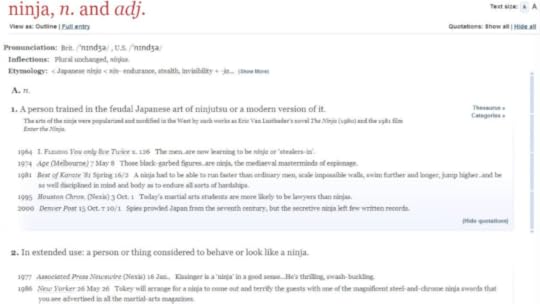
O: Olympics
The 2012 Olympic opening ceremony held in the UK provided many surprises and moments of awe for those viewing the opening of the games. However, nothing matched the sense of shock and overarching joy of seeing Her Majesty the Queen escorted by 007, played by Daniel Craig [Who's Who], from Buckingham Palace to a waiting helicopter. The Queen and Bond then parachute into the London Olympic opening ceremony and provide the world with a royal entrance like nothing that has ever been seen before. Read the OUPblog’s Oxford Companion to the London 2012 Opening Ceremony.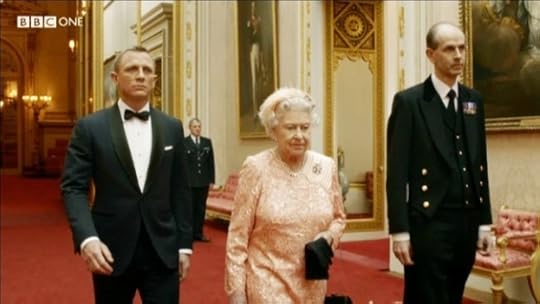
P: Pussy Galore
The names of many of the Bond girls would be enough to make even the most crude man on the planet blush. When Pussy Galore tells Bond her name in Goldfinger, Bond can only reply with ‘I must be dreaming’. But he meets many interesting girls throughout his career with equally interesting names. Kissy Suzuki, Honey Ryder, Plenty O’Toole, Holly Goodhead and Octopussy are all examples of Bond girls. They are all euphemistic, and the allusions don’t stop with the names. Oh no. Some of the best bits of Bond dialogue are built on a smutty foundation of sexual suggestiveness. See this exchange in the 1977 film The Spy Who Loved Me:
M: ‘Miss Moneypenny, where is 007 now?’
Moneypenny: ‘He’s on a mission, sir. In Austria.’
M: ‘Well, tell him to pull out immediately!’
How does that primary school joke go again? ‘If you look up the word euphemism in the Oxford English Dictionary you would see the James Bond films.’ Actually, you wouldn’t. You would see this:

Q: QAnother long-running character in the Bond books and films that was based on a war-time colleague and friend of Ian Fleming’s, “Q” has become known for his ability to create ingenious spy gadgets. Officially, Charles Fraser-Smith was just a temporary civil servant working at the Ministry of Supply during WWII. However, this didn’t stop him creating gadgets for the intelligence services, from shoelaces that concealed saw blades to golf balls that encased compasses. Fleming was influenced by Fraser-Smith in his creation of the character of Q as well as the art of deception throughout WWII. Many British secret service operations during WWII were based on deception and perhaps most famous of all of them is the intriguing tale of Operation Mincemeat. To uncover a world of deceit, mystery and espionage then read Deathly Deception by Denis Smyth.
R: Roger MooreSir Roger Moore [Who's Who] is a well-loved British actor who is best known for his suave portrayal of James Bond between 1973 and 1985. Moore played Bond in seven films and is the longest-serving actor to have played the role of 007. Moore doesn’t take himself too seriously and recently described his portrayal of Bond as a ‘lover and a giggler’ in comparison to Daniel Craig’s image of a cool killer. Apparently, Moore got the role of Bond because he was a gambling friend of the producers of the Bond films Albert R. Broccoli and Harry Sultzman.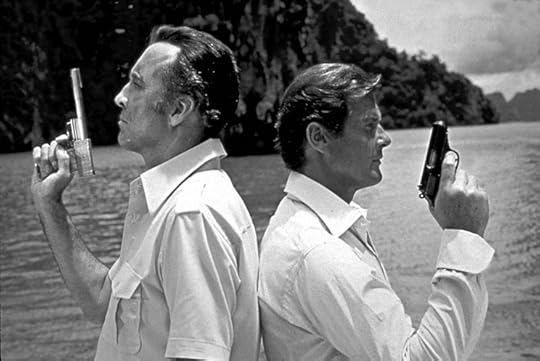
S: Soundtrack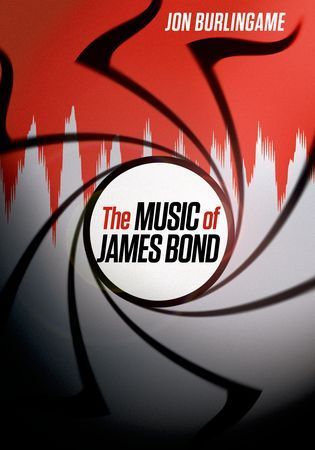 The Bond soundtrack is often the first topic of conversation before the film is released. This year, it was the turn of Adele whose powerful, soulful voice is the backdrop for Skyfall. There have been many controversies throughout the history of Bond soundtrack, not least the story behind the first ever Bond film soundtrack. According to the producers the theme music for Dr. No was written the day before the film finished in production and this song quickly became the subject of a libel court case which lasted nearly 40 years. You can read more about the story behind the soundtrack for Dr. No. in Jon Burlingame’s new book The Music of James Bond.
The Bond soundtrack is often the first topic of conversation before the film is released. This year, it was the turn of Adele whose powerful, soulful voice is the backdrop for Skyfall. There have been many controversies throughout the history of Bond soundtrack, not least the story behind the first ever Bond film soundtrack. According to the producers the theme music for Dr. No was written the day before the film finished in production and this song quickly became the subject of a libel court case which lasted nearly 40 years. You can read more about the story behind the soundtrack for Dr. No. in Jon Burlingame’s new book The Music of James Bond.
John Barry was also the creative visionary behind eight classic Bond soundtracks that ranged from Goldfinger to Thunderball, yet he didn’t receive one Academy Award nomination for his all-action adventure music. Read more about the composer John Barry [Oxford Reference].
T: Tuxedo
The formal black jacket of the Tuxedo, combined with a crisp white shirt and dickie bow, is the iconic wardrobe of Bond. The Tuxedo was born at the end the nineteenth century, when men desired clothing to accommodate the casual nature of leisure time. The Tuxedo jacket provided a new level of formality that sat between full white formal wear and the lounge suit. The word Tuxedo derived from Tuxedo Park, the site of a country club in New York where it was first worn. The Jacket is usually identified by the single button joining the front.
U: Ursula Andress
In Dr. No, the fantastically named Honey Ryder is played by Swiss actress Ursula Andress. However, due to Andress’s heavy accent, Honey Ryder was actually dubbed by Nikki van der Zyl. Not surprisingly, Honey Ryder is a double entendre for a sexual position. The scene involving her emerging from the sea in a white bikini has frequently been voted the sexiest ever James Bond scene…
V: Villains
From Scaramanga to Kananga, Bond villains are often pretty darn evil. The despicable nature of these villains and henchmen is one of the main reasons why Fleming’s novels are still popular 50 years after their inception and why the films still pull in billions at the box office. Perhaps the most famous of all the Bond villains, and the one to appear the most in both the films and Fleming’s books, is Ernst Blofeld. This super-villain was the head of the global criminal organisation SPECTRE and was Bond’s enemy for many years. If you ever catch yourself thinking about an evil bald man stroking a white cat on a swivel chair then immediately seek help; but this is the image of Blofeld that remains entrenched in Bond legend. Charles Dickens is another well-loved British author who was fond of villains; why not check out the first major study of the wicked and deviant in Dicken’s Villains by Juliet John.
W: Weapons and Bond’s Walther PPK
Bond’s issued firearm has not changed throughout the history of Bond films or books. Although his other weapons and gadgets have evolved and got even more ludicrous (invisible water car anyone?) his trusty Walther PPK remains a constant in his tuxedo pocket. Usually only used on henchmen fodder and on the baddies listed in the credits as ‘Bad Guy 1’ etc., this is the standard James Bond gun of choice. The Walther PPK is traditionally a blowback-operated semi-automatic pistol which features an exposed hammer, a traditional double-action trigger mechanism, a single-column magazine and a fixed barrel which also acts as the guide rod for the recoil spring.
X: Xenia Onatopp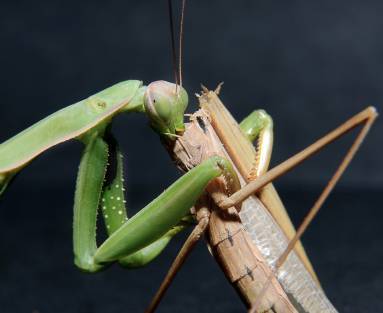 Xenia Onatopp is the seductive and lethal femme fatale of Golden Eye. Played by actress Framke Janssen, Onatopp uses sexual violence as her deadly weapon and finds gratification in her murders. According to the OED, a femme fatale is ‘An attractive and seductive woman, esp. one who is likely to cause risk to or the downfall of anyone who becomes involved with her’. Onatopp seems to match these criteria, especially in the scene where she murders admiral Chuck Farrell during intercourse by crushing him to death with her thighs. If she was to eat him afterwards you could call her a Praying Mantis [Oxford Reference].
Xenia Onatopp is the seductive and lethal femme fatale of Golden Eye. Played by actress Framke Janssen, Onatopp uses sexual violence as her deadly weapon and finds gratification in her murders. According to the OED, a femme fatale is ‘An attractive and seductive woman, esp. one who is likely to cause risk to or the downfall of anyone who becomes involved with her’. Onatopp seems to match these criteria, especially in the scene where she murders admiral Chuck Farrell during intercourse by crushing him to death with her thighs. If she was to eat him afterwards you could call her a Praying Mantis [Oxford Reference].
Y: You Only Live Twice
You Only Live Twice is the fifth film in the James Bond series to star Sean Connery [Who's Who] as the MI6 agent James Bond. In the film, Bond is dispatched to Japan after American and Russian spacecraft disappear mysteriously in orbit. With one side blaming the other, Bond goes undercover on a remote Japanese island to find the perpetrators, bringing him face to face with Ernst Stavro Blofeld, the head of SPECTRE. This film reveals the features of Blofeld, who was previously a partially-unseen character. You Only Live Twice became the quintessential example of the spy film particularly with the supervillain Ernst Stavro Blofeld, his aspirations of world domination, and his extravagant lair in a volcano. As a result the film has been parodied greatly, perhaps most prominently by the Austin Powers series and the scar-faced Nehru suit wearing Dr. Evil.
Sean Connery starred in seven Bond films and was the first actor to play James Bond in a feature length film. He admits that this role kick-started his acting career even though he initially didn’t want to commit to acting in a film series. He now accepts he made the right decision! You can find out more about Sean Connery’s acting career in Who’s Who.
Z: Zao Zao is one of the recent henchmen to join the list of ‘James Bond baddies’. Played by Rick Yune, Zao works for Colonel Tan-Sun Moon in the 2002 film Die Another Day. The most striking characteristic of the character – the embedded diamonds in his face – are caused by Bond when the case of diamonds he is using in a trap blows up in Zao’s face. Diamond is actually the hardest known mineral and is an allotropic form of pure carbon. It is also known as a ‘girl’s best friend’, but that probably didn’t make a difference to Zao.
Zao is one of the recent henchmen to join the list of ‘James Bond baddies’. Played by Rick Yune, Zao works for Colonel Tan-Sun Moon in the 2002 film Die Another Day. The most striking characteristic of the character – the embedded diamonds in his face – are caused by Bond when the case of diamonds he is using in a trap blows up in Zao’s face. Diamond is actually the hardest known mineral and is an allotropic form of pure carbon. It is also known as a ‘girl’s best friend’, but that probably didn’t make a difference to Zao.
Gabby ‘Odd Job’ Fletcher is by day a Press Officer for OUP, but by night, after donning her steel sharpened hat and blade throwing boots, she fights the suave sophistication of tuxedo-clad men.
Daniel ‘Pussy Galore’ Parker is a Publicity Assistant for OUP, who tries (and fails) to act like James Bond.
Subscribe to the OUPblog via email or RSS.
Subscribe to only television and film articles on the OUPblog via email or RSS.
Image credits:
Aston Martin: photograph by Patrick Hutter via iStockphoto.
Skyfall movie poster from 007.com used for the purposes of illustration.
Dr. No movie poster used for purposes of illustration.
Golden girl still from The Music of James Bond (OUP, 2012) under the Fair Use policy.
Live and Let Die movie poster used for purposes of illustration.
Definition of ‘ninja’ courtesy of OED Online.
Daniel Craig and Queen Elizabeth II still of BBC footage via BBC, used for purposes of illustration.
Chris Lee and Roger Moore still from The Music of James Bond (OUP, 2012) under the Fair Use policy.
Ursula Andress behind the scenes of Dr No from The Music of James Bond (OUP, 2012) under the Fair Use policy.
Praying Mantis eats male after mating: photograph by fotofrankyat via iStockphoto.
Diamonds on black surface: photograph by Chatabox via iStockphoto.



October 26, 2012
Friday procrastination: energy pod edition
Many moons ago OUPblog had a “Friday Procrastination” series collecting some interesting (and non-Oxford!) reading from around the web. I’m hoping to kick start it again with what I’ve been reading this week. Any further recommendations are welcome.
The Association of American University Press has started a new series on their blog, including a piece from our own Susan Ferber on the book that inspired her as an editor.
Fight l’appel du vide and read about fascinating words and phrases English should really adopt.
Tufts talks tough on getting your dissertation published.
Gene Sprouse, editor-and-chief of the American Physical Society (APS), talks social media peer-review.
What is the likelihood of me getting one of these energy pods?
I should have trademarked my superhero name “Dark Social“.
OED Appeal highlight this week: bimble, to move at a leisurely pace.
Is there a publishing brain to match the bookstore brain?
Art market disruption and renting art.
And finally, you know those hours you wasted studying? Turns out they might be useful:
#bbpBox_261459870455300096 a { text-decoration:none; color:#0099CC; }#bbpBox_261459870455300096 a:hover { text-decoration:underline; }That chemistry degree I never got? Long chemical names handy doing copyright permissions for book on neuropsychopharmacology. @October 25, 2012 9:31 am via Nimble Reply Retweet Favorite Karen E. Lund
Alice Northover joined Oxford University Press as Social Media Manager in January 2012. She is editor of the OUPblog, constant tweeter @OUPAcademic, daily Facebooker at Oxford Academic, and Google Plus updater of Oxford Academic, amongst other things. You can learn more about her bizarre habits on the blog.
Subscribe to the OUPblog via email or RSS.



The challenges of discoverability
As we approach the one year anniversary of the Oxford Index Beta, Robert Faber, Director of Oxford’s Discoverability Program, reflects on the site’s evolution.
By Robert Faber
In the world of digital scholarship, discovery really matters. There are many new ways of reading content on the web or mobile devices, but making our publications easy to find in the vast ocean of digital information is a growing challenge. When we decided to take this on and set up a “discoverability” program across all Oxford University Press’s global academic publishing, it sounded simple enough: we just have to improve the ways people find and use our content, right? Right … (said our friends, at parties) … and exactly what does that involve? After eighteen hectic months, here’s our answer.
Why does discoverability matter so much?
It’s all about reading. Or, to make it sound more technical, “usage”. If we can’t find it, as readers, we certainly won’t be using it. Meanwhile, our authors want their work to be read, and librarians who make it available to readers want to know it’s useful. For us, as a university press, the fundamental aim is to make high-quality research and education accessible as widely as possible. And the journey begins with discovery.
So where’s the problem?
First we have to recognize that our behaviour as digital users is changing. Typical searches are often now by topic, not by publisher or by journal or book. For example, 80% of traffic to Oxford Journals is direct to the individual article — and fully 50% from Google alone. But there are plenty of other digital byways too.
In fact, there are many, many places where users can find out about our content: on the web, on discipline-based research networks, in library systems. There is no wrong door to our content; any way is a good way. That means we need to ensure readers can find a description of our content (by topic, as they are inclined to search) in any of the places they might want to look.
Increasingly, finding material is a matter of following connections. Citations have always been the common currency of research — whether scribbled on index cards or published as references in finished work. Each is a connection — ‘this tells you more’ — and their importance is growing exponentially as we share more electronically. Showing the connections across our content — by discipline, topic, author, or other common factors — will help researchers and increase the use of that material.
Click here to view the embedded video.
How do you tackle all that?
We decided to audit how easy it was to find our content. OUP’s list ranges widely, from journal articles and monographs to scholarly editions, research reviews and bibliographies, and general reference of all kinds. We found very good practice in some areas, with great free previews of content (for example), but not everywhere, and not in a way that joined things up for researchers. So we decided to consolidate that good practice and build an index to everything we publish: the Oxford Index.
The first step was to put together a standardized description of every item of content in one place. This means we can supply details of everything, consistently, to all the external partners who offer searching through their systems: libraries, research networks, web companies. From sending out just two or three sets of content once in a while, we now offer almost all our online content to an increasing range of partners and update it regularly.
We’ve compiled a common taxonomy, and started making more detailed connections by topic and author. For example, we now have more than 300,000 ‘overview’ pages, each of which help readers identify a topic — such as Pythagoras, Animal Farm, or futurism – and then offer a free reference entry plus links to related material.
Now almost a year old, you can see the Oxford Index Beta site taking shape. It made sense to build our own free, public view of the Index in a way that would be searchable from the web and cross-searchable across Oxford products. Already, more and more results are appearing in Google searches.
The Index is really a big map of all our content, showing you not only how to get there but also what’s in the same neighbourhood. The value is not the map itself, but in where you want to go. And like geographical maps on web pages (what on earth did we do before Google Maps?) we plan to embed the Index wherever and whenever it can be useful. So the brand new version of Oxford Reference includes overviews of all the topics Oxford Reference covers (derived from the Index) — as well as an Oxford Index underbar that shows links to related content across all Oxford products.
So where next?
You’ll see pathways enabled by the Index appearing on many Oxford products from now on, as we connect up this network of trusted information. It’s been a great team effort by data engineers, editors, marketers, and developers and if it works, we’ll have created new ways for users to discover OUP content and find the best, most relevant material. So their journey, and ours, will continue …
Robert Faber is editorial director for reference and director of the discoverability program for Oxford University Press’s Global Academic Business.
The Oxford Index is a free search and discovery tool from Oxford University Press. It is designed to help you begin your research journey by providing a single, convenient search portal for trusted scholarship from Oxford and our partners, and then point you to the most relevant related materials — from journal articles to scholarly monographs. One search brings together top quality content and unlocks connections in a way not previously possible. Take a virtual tour of the Index to learn more.
Subscribe to the OUPblog via email or RSS.



The “Choice” Bazaar
Some years ago I wrote a book on abortion that espoused women’s legal right to choose abortion, which was later cited in Roe v. Wade. It should have made me popular with feminists, but it did not and for one reason: I also argued that abortion is an ethical choice, and that not all abortions would necessarily be good choices. Trained as a philosopher, I pointed out that a traditional part of morality is deciding how to make good choices in the shaping of one’s life. No, I was indignantly told — the choice of abortion is a “personal choice” which needs no ethical justification, by either the woman or anyone else. That’s what women’s freedom is all about.
His Master's choice. (ca. 1932-1934) Arents Cigarette Cards. Source: NYPL.
Around the same time I was having that argument I encountered an exceedingly libertarian advocate of market freedom. He told me it is not up to those who sell things in a free market to pass judgment on the morality of what’s sold or on those who choose to buy them. That’s what market freedom is all about.I thought about those exchanges recently when I started to notice how choice seems to have become the all-purpose ethical term, used by liberals and conservatives, right and left. It is used by the left to defend gay marriage, almost any and all procreation choice, and the right to choose end-of life-care as one sees fit, including physician-assisted suicide.
“Choice” was used by the right to object to the requirement that everyone take out health insurance as part of the new health care legislation. People should be free to make their own choice about buying health insurance (though they lost out as a result of a recent Supreme Court decision). Mayor Bloomberg lost out last year on a proposal to tax people’s choice of sugared beverages, and came under fire this year for his proposal for a limit on their serving size (the ban was recently approved by the New York Board of Health). The beverage industry waged an all-out war against his proposals, citing people’s right to their own choice about how they care for their bodies.
Paul Ryan has been the leader of Republican efforts to reform Medicare by expanding the role of choice in deciding what kind of health insurance to buy under his plan to subsidize the program. But there is a twist in that instance about choice. The aim of that reform is to expand the range of choices not only in the name of freedom but also to control costs — putting “skin in the game,” as the saying goes. But it is well known that forcing money choices on patients often keeps them from doing things important for their health. The Republicans also rejected any feature in the drafting of the Affordable Care Act that would impose pressure on physicians to accept the results of good medical evidence from research. They should be completely free from government interference and allowed to make their own diagnostic and treatment choices.
Quite apart from the political use of the word, “choice” has also been a recurrent feature of the marketing of new medical technologies. Many are introduced in the name of expanding patient choices. Prenatal diagnosis for women at possible risk of a disabled child was introduced in the name of choice, putting no pressure on women one way or other to accept the procedure. But as a result of social pressure and in the name of responsible parenthood, it is almost as routine now as taking a pregnant woman’s blood pressure. A variety of new genetic tests can now determine someone’s likely medical future, including the possibility of Alzheimer’s and just about every other potentially lethal disease. No one will be forced to make use of that information; it will be a matter of choice, it is said. But if the history of new technologies is any guide, it will soon be considered ethically irresponsible not to make use of them.
What is to be made of the invocation of “choice” as a popular tool for winning a political battle — or of rejecting “choice” as the right way to win an ethical struggle? It depends on the other side of the coin. I believe public health trumps choice in the sugared beverage battle. Is it legitimate to use the word choice as a euphemism for unpopular causes? I don’t think so. Paul Ryan is using it in a way that hides the gradual reduction of Medicare benefits. Euthanasia supporters are either hiding or sugar-coating their policy goals. When new technologies are introduced in the name of choice should we believe it? Well, only if you want to ignore lessons from past technological innovations.
That’s all I choose to say for now.
Daniel Callahan is President Emeritus of The Hastings Center and author of the forthcoming book, The Roots of Bioethics: Health, Progress, Technology, Death (Oxford University Press).
Subscribe to the OUPblog via email or RSS.
Subscribe to only philosophy articles on the OUPblog via email or RSS.
View more about this book on the 




Presidential campaigns: replicating Reagan

By Gil Troy
Although he last ran for office nearly 30 years ago, and died eight years ago, Ronald Reagan remains a surprisingly strong presence on today’s campaign trail. It is not just the multiple times Republican candidates’ invoked his name during the primary debates. It is not just that Americans are still debating Reagan’s cry to shrink the federal government. It is not just that Barack Obama has said he wants to be as transformational a president as Reagan was and Mitt Romney says he wants to follow the Reagan playbook – or that Newsweek has a cover story renaming the President “Barack Reagan.” It is also that each of the two candidates is trying to replicate a Reagan electoral feat.
Mitt Romney is trying to conjure up the spirit of 1980. During those days of economic trauma, low morale, and national angst, a remote, gaffe-prone Republican candidate – who even believed that trees caused more air pollution than cars – was stuck in a tight race against an unpopular, cerebral opponent whose rocky first term belied the euphoria his quick ascent to the Oval Office had generated four years earlier. Ronald Reagan sealed his victory over Jimmy Carter with an effective debate performance, including his avuncular dismissal of Carter’s attacks with the kiss-off line “There you go again.” After the debate, the Gallup Poll recorded its largest candidate jump in the polls since polling began, approximately ten points in Reagan’s favor. On Election Day, Reagan defied the expectations, and silenced the scoffers.
Obama is hoping that 2012 will be more like 1984 than 1980. That year, an embattled incumbent whose party suffered serious electoral setbacks two years earlier, and had struggled to jumpstart the economy, won reelection with a triumphal campaign over a weak opponent. Ronald Reagan’s “Morning in America” campaign not only won Reagan four more years, it shaped the legend of Ronald Reagan, the president who brought peace, patriotism, and prosperity back to America.
Click here to view the embedded video.
Of course, history, like a winning army, only marches forward, and, as in sports, there are no do-overs. The two candidates can learn from Reagan’s successes – but they also should learn from Reagan’s failures. Reagan pretended that his 1981 win was a mandate for change, when it was basically an anti-incumbent, ABC election – with Americans choosing Anybody But Carter. And in 1984, Reagan scored more of a personal victory than a party victory; his Olympic pride and apple pie campaign had been so vague that he retained power but had trouble governing.
Whoever wins in 2012 will need broad support to lead. While running to win this fall, both candidates need to think about the day after, about how to unite the country and move forward. Such considerations should keep the campaign more constructive and more centrist than it has been, given that the President has to lead all the people. And the President needs a vision. Otherwise, he will echo the famous movie, “The Candidate.” In that 1972 movie, Robert Redford plays a longshot candidate who wins a tough Senate race. The movie ends with the famous tagline “What do we do now?”
Gil Troy is Professor of History at McGill University in Montreal, and a Visiting Scholar affiliated with the Bipartisan Policy Center in Washington. He is the author of The Reagan Revolution: A Very Short Introduction (OUP, 2009), Moynihan’s Moment: America’s Fight Against Zionism as Racism (OUP, 2012), and co-editor of Living in the Eighties (OUP, 2010). Follow @GilTroy on Twitter.
The Very Short Introductions (VSI) series combines a small format with authoritative analysis and big ideas for hundreds of topic areas. Written by our expert authors, these books can change the way you think about the things that interest you and are the perfect introduction to subjects you previously knew nothing about.
Subscribe to the OUPblog via email or RSS.
Subscribe to only VSI articles on the OUPblog via email or RSS.
Subscribe to only politics and law articles on the OUPblog via email or RSS.
View more about this book on the 




October 25, 2012
The 50th anniversary of Nelson Mandela’s imprisonment
This October 25th marks the fiftieth anniversary of the beginning of Nelson Mandela’s twenty-seven years in South African prisons. He was initially sentenced in October, 1962 to five years imprisonment for inciting African workers to strike and for leaving the country without valid travel documents. Immediately after sentencing, he was sent to the Robben Island prison, lying off Cape Town harbor, where he was held in solitary confinement. He was brought back to Pretoria, the South African administrative capital, less than a year later to face even more serious charges under the Sabotage Act — charges that could have resulted in a death sentence. Those subsequent charges culminated in the Rivonia trial — a trial that was to last from October, 1963 until June, 1964 and constitute one of the most dramatic political trials in world history. The Rivonia trial resulted in a life sentence.
Although perhaps historically dwarfed by Rivonia, the 1962 trial was itself a significant moment in South African history and in the formation of the man, Nelson Mandela, and his legend. The trial was held in a building that had been converted from an old synagogue to a court. Mandela, although he had been advised by two skilled and experienced criminal defense lawyers, Harold Wolpe and Joe Slovo, elected to represent himself. He was an experienced lawyer and his initial act was to seek to recuse the magistrate who was to try the case. In his application for recusal, Mandela respectfully stated that there was nothing personal in his motion. Rather, he objected that he would not be given a fair and proper trial by a white judicial officer, “however high his esteem and however strong his sense of fairness and justice.” Whites had denied black Africans the right of representation in Parliament. He added, “it is improper and against the elementary principles of justice to entrust whites with cases involving the denial by them of basic human rights to the African people.”
The magistrate summarily denied Mandela’s application for recusal. Mandela pled not guilty and the State presented its case. Mandela was an active cross-examiner but offered no evidence in his own defense. Not surprisingly, he was found guilty. He was permitted to make a statement in mitigation of sentence. The statement outlined the history of the struggle of African people and his own involvement in that struggle. He concluded:
Whatever sentence Your Worship sees fit to impose upon me for the crime for which I have been convicted before this court, may it rest assured that when my sentence has been completed, I will still be moved, as men are always moved, by their consciences. I will still be moved by my dislike of the race discrimination against my people when I come out from serving my sentence to take up again, as best I can the struggle for the removal of those injustices until they are finally abolished once and for all.
Almost two years later, when facing the possibility of a death sentence at the Rivonia trial, he concluded with a similar statement, although under the circumstances, in a more dramatic tone:
During my lifetime I have dedicated myself to this struggle of the African people. I have fought against white domination and I have fought against black domination. I have cherished the ideal of a democratic and free society… It is an ideal which I hope to live for and to achieve. But if need be it is an ideal for which I am prepared to die.
Mandela’s words from the Rivonia trial are now enshrined on the wall of the Constitutional Court building in Johannesburg.
Nelson Mandela did not die either by hanging or in a South African prison. He survived the full legal onslaught of the apartheid State. He was convicted both in 1962 and at the Rivonia trial in 1964. But on both occasions he maintained his dignity and resisted, as best he could under the circumstances, the legal cases against him. And in both trials, he successfully made his case for the struggle against an oppressive regime and against racism all over the world.
Nelson Mandela’s brilliance at these two trials would have been historically important even if he had not survived to lead his country to a new constitutional democracy. His articulation of the case for his cause would serve as inspiration for his people and for all people fighting oppression. But just as importantly, his contribution to his own survival insured that this great man would be alive to provide the leadership necessary for South Africa to go beyond its oppressive past.
His imprisonment, which began 50 years ago, would last for twenty-seven years. The leadership that he gave his people, in the courtroom, in prison and after his release, will last for the ages.
Kenneth S. Broun is the Henry Brandis Professor of Law at the University of North Carolina Law School. Since 1986, he has traveled regularly to South Africa to conduct programs in trial advocacy training through the Black Lawyers Association of South Africa. He is the author of Saving Nelson Mandela: The Rivonia Trial and the Fate of South Africa. Read his previous blog post: “Nelson Mandela, 22 years after his release from prison.”
Subscribe to the OUPblog via email or RSS.
Subscribe to only law and politics articles on the OUPblog via email or RSS.
Subscribe to only African history articles on the OUPblog via email or RSS.
View more about this book on the 

Image credit: 6th April 2000 Visit of Nelson Mandela to give a lecture at LSE on ‘Africa and Its Position in the World.’ Held at the Peacock Theatre. London School of Economics.



Music events to see in New Orleans 1-4 November
Greetings to all of you in New Orleans for the American Musicological Society (AMS)/Society for Ethnomusicology (SEM)/Society for Music Theory (SMT) conference. I’ve been writing about the music of New Orleans dating back to the mid-1970s and am still making discoveries to this day. The city is a seemingly bottomless well of creative musicians, with more arriving every day from around the world seeking the muse that inspires this magic, spiritual sound. Here are a few suggestions about where you might want to go over the next few days to hear this aural cornucopia in person. These recommendations are really just the tip of the iceberg, but they reflect what I am likely to be hearing myself.
THURSDAY NOVEMBER 1
New Orleans puts its best musical foot forward over the weekend of 1-4 November. Many of the city’s most talented performers will be playing, making for some tough choices. Top pick is a free concert at Armstrong Park featuring Los Hombres Calientes, a Latin jazz band featuring trumpeter Irvin Mayfield and percussionist Bill Summers; and the great trumpeter Leroy Jones. 6:15 p.m.
Other shows of interest include:
Apple Barrel: Alabama Slim and Little Freddie King. Terrific local blues. Little Freddie King was featured in a recent episode of HBO’s “Treme.” 11:00 p.m.
Blue Nile: Bayou International Sound System feat. DJ T Roy. Top reggae dance party in town. 10:00 p.m.
Buffa’s Lounge: Aurora Nealand and Tom McDermott. Extraordinarily talented clarinet/piano duo. McDermott has his own chapter in “New Atlantis.” 8:00 p.m.
Café Istanbul: Michaela Harrison. Wonderful jazz vocalist. 8:30 pm
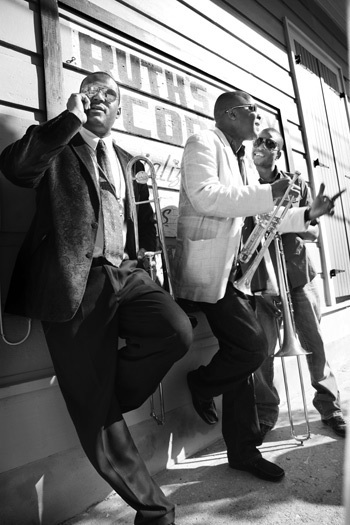
Left to right: Glen David Andrews, James Andrews, Troy "Trombone Shorty" Andrews. Photo by Elsa Hahn. Used by permission of Elsa Hahn.
Carousel Bar (Hotel Monteleone): David Torkanowsky. Solo piano. 4:30 p.m., George French Trio feat. Ellen Smith. Traditional jazz and R&B. 8:00 p.m.
Chickie Wah Wah: Paul Sanchez. One of the city’s best songwriters at a very nice club off the Canal Street streetcar. His story is covered in detail in “New Atlantis.” 9:00 p.m.
Davenport Lounge (Ritz-Carlton): Jeremy Davenport. Upscale hotel gig recalls Rat Pack glories. 5:30 p.m.
I Club (J.W. Marriott): Glen David Andrews. Trombonist/vocalist is one of the city’s most talented performers. He’s one of the stars of “New Atlantis” as well as “Treme”. A must see. 8:00 p.m.
Rock ‘n’ Bowl: Rosie Ledet. Top notch zydeco at a bowling alley. 8:30 p.m.
Snug Harbor: Maria Muldaur and the Bluesiana Band. Legendary blues vocalist. 8 & 10 p.m.
Vaughan’s: Kermit Ruffins and the BBQ Swingers. One of the signature gigs in New Orleans. Trumpeter/entertainer and “Treme” star Ruffins holds court in a delightful evening which usually features his barbecue on the side. 9:00 p.m.
FRIDAY NOVEMBER 2
Top pick tonight is the Tribute to James Booker featuring the All-Star Piano Summit. Ten of the best local pianists offer homage to one of the greatest New Orleans keyboardists. I Club (J.W. Marriott). 8:00 p.m.
Other shows of interest include:
Blue Nile: Kermit Ruffins and the BBQ Swingers 7:00 p.m., Brass-A-Holics 11:00 p.m.
d.b.a.: Hot Club of New Orleans. Gypsy jazz. 6:00 p.m., Honey Island Swamp Band. Roots rock. 10:00 p.m.
Irvin Mayfield’s Jazz Playhouse: Professor Piano Series feat. Joe Krown 5:00 p.m., Leon “Kid Chocolate” Brown. Fabulous trumpeter and vocalist. 8:00 p.m., Burlesque Ballroom feat. Trixie Minx and Romy Kaye. Fascinating mixture of artful burlesque dancing and jazz. 11:59 p.m.
Preservation Hall: Preservation Hall Jazz Masters feat. Leroy Jones. Jones playing traditional jazz in its most elemental form in a venerable setting. 8:00 p.m.
Snug Harbor: Ellis Marsalis Quartet. The dean of New Orleans pianists in his regular gig. 8:00 & 10:00 p.m.
Spotted Cat: Andy J. Forest 4:00 p.m., Andy J. Forest and St. Louis Slim 6:00 p.m., New Orleans Cottonmouth Kings. Forest is a top blues singer, songwriter and harmonica player who appears in “New Atlantis.” St. Louis Slim plays stylish acoustic blues guitar and the Kings play a lively modernization of traditional New Orleans jazz. 10:00 p.m.
Three Muses: Aurora Nealand the Royal Roses. The extraordinarily gifted clarinetist leading her own band. 6:00 p.m.

Leroy Jones and his wife Katja at their home in Treme. Photo by Elsa Hahn. Used by permission of Elsa Hahn.
SATURDAY NOVEMBER 3
Tomorrow and Sunday there is a zydeco festival at the Audubon Zoo. This is always a lot of fun and the zoo is great fun in and of itself. Take the St. Charles streetcar and walk through Audubon Park. Louisiana Swamp Fest 10:00 a.m.
Other shows of interest include:
d.b.a.: John Boutte. The star of “Treme” and author of its well-known theme song also appears in “New Atlantis.” 8:00 p.m., Recent Grammy winners Rebirth Brass Band 11:00 p.m.
I Club (J.W. Marriott): Los Hombres Calientes. 10:00 p.m.
Irvin Mayfield’s Jazz Playhouse: Joe Krown Swing Band 8:00 p.m., Brass-A-Holics 11:59 p.m.
Maple Leaf: 101 Runners. Mardi Gras Indian funk. 10:30 p.m.
Palm Court Jazz Café: Lionel Ferbos and Palm Court Jazz Band. Ferbos is still going strong at 101 years of age. 8:00 p.m.
Spotted Cat: Panorama Jazz Band 6p, Davis Rogan Band. See Sunday listings. 10:00 p.m.
Steamboat Natchez: Duke Heitger’s Steamboat Stompers 11:30a & 2:30 p.m., Dukes of Dixieland 6:00 p.m.
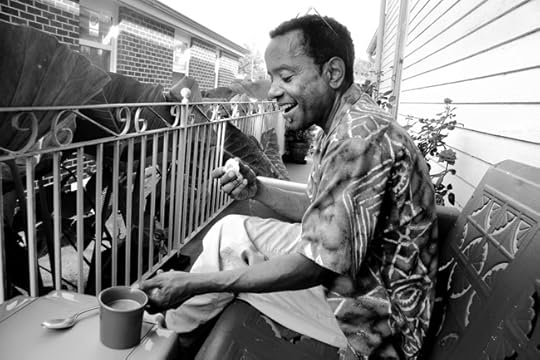
John Boutte. Photo by Elsa Hahn. Used by permission of Elsa Hahn.
SUNDAY NOVEMBER 4
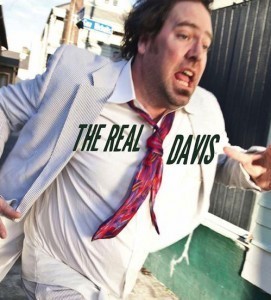 Top pick tonight is Davis Rogan at Buffa’s Lounge. Rogan is the musician who inspired Steve Zahn’s character Davis McAlary in HBO’s “Treme.” He’ll perform before and after this week’s episode is aired. Don’t miss this. 8:00 & 10:00 p.m.
Top pick tonight is Davis Rogan at Buffa’s Lounge. Rogan is the musician who inspired Steve Zahn’s character Davis McAlary in HBO’s “Treme.” He’ll perform before and after this week’s episode is aired. Don’t miss this. 8:00 & 10:00 p.m.
Other shows of interest include:
Audubon Zoo: Louisiana Swamp Fest 10:00 a.m.
Funky Pirate: Pfister Sisters 10:00 a.m.
House of Blues: Gospel Brunch feat. Electrifying Crown Seekers 10:00 a.m.
Kermit’s Speakeasy Restaurant: Kermit Ruffins and the BBQ Swingers 6:00 p.m.
Mojitos: Kevin Clark and Tom McDermott 11:30 a.m.
Palm Court Jazz Café: Mark Braud and Sunday Night Swingsters. Braud is an outstanding trumpet player who often appears at Preservation Hall. 8:00 p.m.
John Swenson is the author of New Atlantis: Musicians Battle for the Survival of New Orleans, which won the 2011 JazzTimes Critics Poll “Book of the Year” Award. He has been writing about popular music since 1967. He edited the website jazze.com for Knit Media and has worked as an editor at Crawdaddy, Rolling Stone, Circus, Saturday Review, Rock World, and OffBeat magazine, while publishing articles in virtually every American popular-music magazine of note. Among his previous books are biographies of Bill Haley, John Lennon, Simon and Garfunkel, and Stevie Wonder, as well as reference works such as The Rolling Stone Jazz Record Guide. In addition, his writing has won two awards from the Press Club of New Orleans: Best Entertainment Feature in 2007 and Best Critical Review in 2008.
Subscribe to the OUPblog via email or RSS.
Subscribe to only music articles on the OUPblog via email or RSS.
View more about this book on the 

Image credit: David album promotional image. Used for the purposes of illustration.



Solo or duet? Married couples in the American National Biography
What are the chances, I wondered, of having separate entries for a married couple in the American National Biography Online (ANB)? I’m still new to my job as the general editor of the ANB, but it struck me as intriguing that the very first update released on my watch will contain one such couple: country music singers Johnny Cash and June Carter Cash. Joined together in marriage and music, they both led fascinating lives that earned them inclusion – separately — in the ANB.
Johnny Cash was born in Arkansas and discovered music early. In 1955 he came to the attention of Sam Phillips at Sun Records in Memphis, who launched him on a five-decade career which included fifty hit singles and album sales approaching fifty million. In the meantime June Carter was growing up in the “First Family of Country Music” as the daughter of Mother Maybelle Carter. Johnny Cash and June Carter first met backstage at the Grand Ole Opry in 1956, and in 1961 she joined his touring show. Although they did not marry until 1968, their lives, both musically and personally, became intertwined. Cash especially credited his future wife with helping him overcome his addictions to alcohol and drugs. June Carter Cash died in May 2003, and her husband died four months later.

Johnny Cash and June Carter Cash in 1969
How do editors decide whether members of a famous couple deserve separate entries or a joint one? In cases like Cash and Carter, it was pretty clear: each had an independent performing career and each had an enormous impact on the field of country music. Naturally, there is some overlap when reading the two entries side by side, but the authors (Bruce Evensen for Johnny Cash, and Patrick Andelic for June Carter Cash) choose different examples and themes so that each entry stands on its own.
Once I started to think about this, I realized that this question has come up for several entries we’re working at the moment. Take the case of Gerald and Betty Ford, whose entries will appear in future updates. Gerald Ford deserves extensive treatment of his presidential administration, as well as his political career leading up to his selection as vice-president and his role in the Republican Party after he left office in 1976. The ANB routinely includes all First Ladies; a recognition, I suspect, of their political celebrity no matter how anomalous the job is. But Betty Ford probably would have been included even if she hadn’t been First Lady, because of her leadership in founding the Betty Ford Center and her candor about confronting her own addictions. In her own way, her influence on the culture rivals that of her husband.
Another power couple who will warrant separate ANB entries is Sargent and Eunice Shriver. To write Sargent Shriver’s entry, I will look for a scholar who is grounded in foreign policy and can provide a balanced interpretation of the Peace Corps, of which Sargent Shriver served as the first director. For Eunice, I will seek out someone who can do justice to her work at the Special Olympics and her advocacy of those with special needs. Of course, each author will also have to deal with the whole Kennedy mystique, but that is what makes these short entries fun and challenging to write.
However, there have also been cases where a joint entry does in fact make the most sense. Mimi Farina is often best known as Joan Baez’s sister but she was an influential folksinger in her own right. So was her husband, Richard Farina, although his life was cut short in his 20s by a motorcycle accident. Treating the two lives in tandem will allow for a full treatment of the world of folk music in the 1950s and 1960s that produced these talented musicians, and allow Richard to be included in the historical record even though his individual accomplishments were limited by his premature death.
My final example is of a forthcoming joint entry of a couple who weren’t married or even romantically linked, but worked together as a team their entire careers. Adolph Green and Betty Comden wrote the lyrics, libretti, and screenplays for many of Hollywood’s and Broadway’s best-known musicals. Their working lives were so intertwined, said my friend Carol Oja who is co-authoring the ANB piece, that it would be impossible to write the life of one without the other. In this case, the entry will include separate biographical information about their early lives, but once they team up, tell their story together.
Making decisions like these is part of the general editor’s job description, I am learning. And often they need to be made on a case-by-case basis. But that is one of the things that makes this job so interesting.
Susan Ware is the General Editor of the American National Biography.Susan Ware is the new General Editor of American National Biography. She is an accomplished historian, editor, and the author of seven books, including biographies of Billie Jean King, Amelia Earhart, Molly Dewson, and Mary Margaret McBride. Read Susan’s plans for the ANB in this OUPblog post.
The landmark American National Biography offers portraits of more than 18,700 men and women — from all eras and walks of life — whose lives have shaped the nation. First published in 24 volumes in 1999, the ANB received instant acclaim as the new authority in American biographies, and continues to serve readers in thousands of school, public, and academic libraries around the world. Its online counterpart, ANB Online, is a regularly updated resource currently offering portraits of over 18,700 biographies, including the 17,435 of the print edition. ACLS sponsors the ANB, which is published by Oxford University Press.
Subscribe to the OUPblog via email or RSS.
Subscribe to only American history articles on the OUPblog via email or RSS.
Image credit: Photograph of Johnny Cash and June Carter Cash by Joel Baldwin, 1969, via Library of Congress, Prints and Photographs Division [in public domain].



October 24, 2012
An etymologist among the gods
Etymology, a subject rarely studied on our campuses, enjoys the respect of many people, even though they persist in calling it entomology. Human beings always want to know the origin of things, but sometimes etymology is made to carry double, like the horse in O. Henry’s story “The Roads We Take.” For instance, it is sometimes said that etymology helps us to use words correctly. Alas, it very seldom does so. If someone asks us about the meaning of the adjective debonair and is not only informed that a debonair man is genial, suave, and so forth but also that the adjective goes back to the French phrase de bon aire “of good disposition (nature),” this may help. But learning that the Gothic cognate of Engl. mad means “crippled” or that the historical sense of Engl. budget is “a small (leather) bag” will only confuse the speaker. Even in learning to spell etymology is rarely of service. Tuesday has ue, sleuth has eu, tube feels perfectly at ease with u, two end in wo, too is fine with oo, new has no problems with ew, unlike nu in painting, which, not unexpectedly, ends in nothing, unless you stick to French nue. And don’t forget shoe, you and ewe. The vowel in all of them is the same. A feeble explanation of each variant exists. Is a student of elementary English supposed to care? I am afraid not. (If your native language is American English, guess what The Nu Project means.) But knowing the origin of words often tells us something about the origin of things. In this respect, few examples are more trivial than lord and lady. The first of them means, from a historical point of view, “bread warden” (only one should think of loaf, rather than bread, to be able to connect the dots), while the lady of the household was a “bread kneader.” The development of both senses is instructive.
Of special interest is the meaning of divine names. Germanic myths that at one time had circulation outside Scandinavia are lost, but medieval Iceland preserved numerous tales of the pagan gods whom people venerated before their conversion to Christianity. A study of their ancient faith reveals a lost world of beliefs and superstitions. The role of etymology in the reconstruction of that world is modest but not insignificant. At the very least it can pose questions worthy of asking. For example, one of the gods was called Frey (in Icelandic, Freyr). Despite some recent attempts to disprove the common explanation, the name probably means what everybody has always thought, that is, “lord.” But in the extant myths, he is not the main figure of the pantheon. Was he such at one time? If we did not know the meaning and the origin of the word, this question would not have arisen.
In the epoch of the Vikings, everybody’s favorite was Thor (in Icelandic, Þórr), and we know for sure that Thor is a regular cognate of Engl. thunder (I’ll skip the phonetic niceties and refrain from discussing how the two forms match). Yet in the preserved corpus of Scandinavian myths Thor had nothing to do with thunder: he was a giant slayer. Luckily, etymology points the way to the past, and we begin to search for the traces of the old cult. Then we notice that Thor had a chariot (though he seldom used it), as a traveling sky god should. And he also had a hammer called Mjöllnir. This name bears a striking resemblance to the Russian word molniia “lightning.” Perhaps this resemblance is due to chance, but, more probably, not. From the nature of things a thunder god is connected with clouds and rain, and rain lets crops grow. Thunder and fertility cannot be separated. In at least two myths we are told directly that Mjöllnir was used to consecrate marriage (it was put in the lap of the bride) and possibly to guarantee the continuation of life. (Mjöllnir was not a phallic symbol, because symbols and allegories, as I think, are alien to myths; it was a substitute of Thor’s organ of procreation, and his ithyphallic figurine graces all albums of Viking art.) As long as we remember that Thor means “thunder,” all those disparate motifs fall into place.
Þórr is a comparatively rare case because we do not doubt that this name is related to the word thunder. More often the etymology of a divine name is disputable or even opaque. In the extant corpus of Scandinavian myths, the main god was Odin (Icelandic Óðinn, Old Engl. Wodan, Old High German Wuotan). He presided over war and death, as well as over magic and poetry. Next to nothing is known about his distant origin. Old Icelandic óðr means “mad,” and Modern German Wut means “fury.” When and why was Odin endowed with being furious? A mountain of articles and books has been written on the nature and descent of this god. Perhaps at one (very remote) time, he was feared and worshiped as predominantly or only a god of death, and fury constituted his main attribute. But nineteenth-century scholars detected a root in his name that they explained as “wind” and thought that in the remotest past he was not mad or furious but rather the embodiment of the storm. Some mythologists still think so, and I disagree with them respectfully but heartily.

Víðarr tearing apart Fenrir at the final battle of Ragnarök
Be that as it may, a thin thread connects the modern meaning of Odin’s name and his real or putative role in people’s beliefs. Sometimes this thread is so thin as to be almost invisible. Occasionally it even seems to lead us astray. The most terrible monster of the Scandinavian mythical world was Fenrir, the wolf who in the final battle (Ragnarök) killed Odin and was torn apart by Odin’s son Vidar (Icelandic Víðarr). We may be almost certain that the root of Fenrir is fen, that is, ‘swamp.’ But wolves do not inhabit swamps! A central goddess of the pantheon (Frigg) lived in a palace called Fensalir “Fen Hall(s).” She had nothing to do with swamps either. Whence this fixation on “fens”? True, the old Germanic peoples constantly fought with swamps and suffered from the fevers that came from the pestiferous bogs of the North. Grendel, the first enemy of Beowulf, had his home in a place called mere in Old English—perhaps the sea, perhaps a forbidding marsh. Still, why did Fenrir have such a strange name, and why did Frigg live in Fensalir? Etymology does not enlighten us on this score, but once again it makes us ponder an important question.
The most pathetic figure of the Scandinavian pantheon was Odin’s son, the shining god Baldr (Engl. Balder). According to one version, he was killed by a blind god at the instigation of Loki, a suspicious character. To reconstruct the mythology of the victim and the evil counselor, that is, to present a convincing picture of how those divinities came to be and developed, it would be important to understand the meaning of their names, because once both names were as transparent as, for example, today’s Snow White and Rose Red. But the oldest functions of Balder and Loki are controversial, and the cruelest law of etymology dictates that to guess the origin of a word, we have to know the meaning of the thing. In my opinion, Loki is allied to German Loch “hole.” Odin, as I see it, was an active corpse hunter and devourer, while Loki guarded the “hole” in which the dead were interred and did not allow the dead to return to the world of the living. Bald- in Baldr seems to be akin to Engl. bald “white,” as in bald eagle (bald eagles are not “hairless”; the modern meaning of bald is the product of later development). The god of a shining sky was killed by a blind (“dark”) god of the underworld.
What I said about Odin holds for Loki and Balder. Dozens of hypotheses about the history of their names compete in the scholarly literature. Since we are not sure of what Balder and Loki did at the beginning of time, the origin of the names will of necessity remain unclear. In such matters, etymology is sometimes a good servant, but it can be a treacherous master. However, it provides the historical linguist, with a pass to Olympus and Valhalla. Patient and unflinching, an etymologist walks unobserved among the gods as their equal, even as their judge. Who else can boast of such an achievement?
Anatoly Liberman is the author of Word Origins…And How We Know Them as well as An Analytic Dictionary of English Etymology: An Introduction. His column on word origins, The Oxford Etymologist, appears here, each Wednesday. Send your etymology question to him care of blog@oup.com; he’ll do his best to avoid responding with “origin unknown.”
Subscribe to Anatoly Liberman’s weekly etymology posts via email or RSS.
Subscribe to the OUPblog via email or RSS.
View more about this book on the 

Image credit: A part of the Gosforth Cross showing a humanoid figure tear apart the jaws of a monster. Usually interpreted to be Víðarr’s battle with Fenrir at Ragnarök. Signed “M Petersen” in the upper left corner. It would seem that this is the upper part of the east-facing side of the shaft of the Gosforth Cross. 1913 reproduction. Photographed from Finnur Jónsson (1913). Goðafræði Norðmanna og Íslendinga eftir heimildum. Híð íslenska bókmentafjelag, Reykjavík. Page 83. via Wikimedia Commons.



Oxford University Press's Blog
- Oxford University Press's profile
- 238 followers



